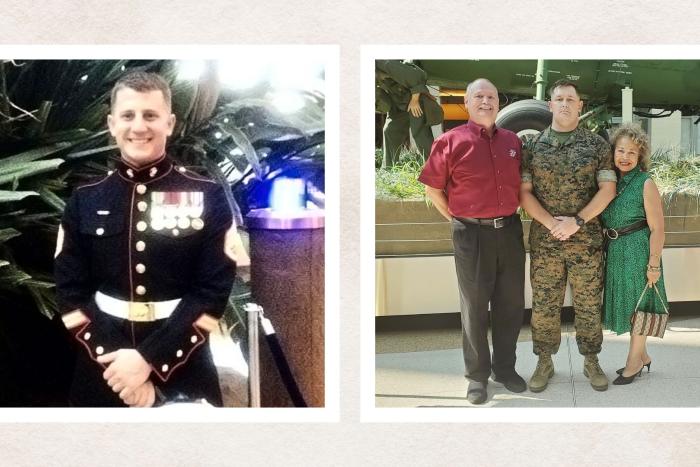
( L to R) Lisa Rettig, Sharon Brinkley, Gauri Gulati, M.D., and Kristie Bonovitch show a packaged Nuzzi, which is a breastfeeding aid the four invented. Lisa, Sharon and Kristie are nurses in VCU Health’s Mother-Infant Unit and Gauri is assistant professor of pediatrics.

Lisa Rettig (left) and Kristie Bonovitch, both nurses in VCU Health’s Mother-Infant Unit, show a packaged Nuzzi, which the two invented alongside VCU Health colleagues Sharon Brinkley, a nurse in the Labor and Delivery Unit, and Gauri Gulati, M.D., assistant professor of pediatrics.

The Nuzzi sits on display with its packaging. It will be ready for public use after a six-month clinical trial that is expected to show increased duration, comfort and overall success among participants who are breastfeeding using the device.

The VCU Innovation Gateway team poses in the atrium of the Biotech One building on the MCV Campus. (Back row, L to R) Ann Boelzner, accountant; Michael Mancini, Ph.D., manager of business development; Ivelina Metcheva, Ph.D., executive director; Tyler Ferro, licensing liason; and Afsar Q. Mir, licensing associate. (Front row, L to R) Brent Fagg, licensing associate; Livia Horton, intellectual property administrator; Magdalina Morgan, Ph.D., licensing associate; and Zena Singh, office manager.
The Nuzzi: Providing Breastfeeding Mothers an Extra Hand
An unwelcome reality sets in for many new mothers when a newborn doesn’t instinctively know how to latch.

VCU Health nurses Kristie Bonovitch, Lisa Rettig and Sharon Brinkley, along with Gauri Gulati, M.D., assistant professor of pediatrics, have guided their patients through this difficult learning process almost daily for about 20 years.
“We’ve seen mothers in tears because they’ve had to stop or can’t start breastfeeding,” Lisa told us. “Breastfeeding is the one thing that gives every baby a chance at having good nutrition — it levels the playing field. If everyone would breastfeed, childhood obesity would be reduced and people would have a better chance at leading healthy lives.”
“When a mother comes in and wants to breastfeed, it’s everything to them,” Kristie said. “It’s natural, but it rarely goes as easily as people expect. They just want somebody to do anything to help them along the way.”
Kristie, Lisa, Sharon and Dr. Gulati, all lactation experts, usually offer a much needed “third hand” to support a mother’s breast and facilitate latching. Their goal, though, is to teach mothers to breastfeed on their own, so over the years they’ve found themselves reaching for burp cloths, wash cloths, baby blankets or anything else that the mothers might have available when they go home that could act as the “third hand” to provide support.
Of course, using random items from around the house is far from ideal and never works quite the same more than once, so the team decided to do something to help their struggling patients.

While at dinner one evening in 2015, the team pooled their more than 75 years of experience to envision and plan the Nuzzi, a sling-like device that wraps around a woman’s upper body and goes under her breast to provide support during breastfeeding. This support frees a mother’s hand to help express milk and/or comfort the baby.
“Working with mothers in both the hospital setting as well as the outpatient breastfeeding clinic at the Children’s Hospital of Richmond at VCU, I have found that when we can provide support for a mom that she can duplicate at home independently, her confidence is increased in her ability to feed her baby,” Dr. Gulati said. “The Nuzzi takes the place of my hand in helping her achieve a good latch and position, and it promotes a more comfortable feeding session.”
Thanks to Sharon, who has a degree in textiles and is a seamstress, the team soon had a prototype for their idea, but they didn’t know what to do next.
VCU Innovation Gateway
That’s when they turned to VCU Innovation Gateway, which is a team of licensing associates, business developers and administrators who help VCU and VCU Health System faculty and staff commercialize their inventions and creative work.
“When our faculty or clinicians encounter problems, they find solutions,” said Ivelina Metcheva, Ph.D., executive director of Innovation Gateway. “We nurture this culture of innovation throughout the university and the health system, and then we make sure these products and technologies make it out of the lab to the bedside or the market so they can benefit the public.”
When the Nuzzi team went to Innovation Gateway with their invention, they connected with licensing associate Magdalina Morgan, Ph.D., who said her first two steps when she is approached with a product are to check whether it’s patentable and whether there is a market for it.
Sharon’s expertise in textiles was critical at this stage as she developed several iterations of the prototype to maximize functionality and comfort, preparing the Nuzzi for patent submission.
With Magdalina’s help, the Nuzzi team applied for and received a design patent for the Nuzzi. “When it comes to the market for this product, it’s pretty much unlimited with the current focus on breastfeeding and breastfeeding-friendly places,” Magdalina said. “With VCU Health being designated as a Baby-Friendly Hospital, this is a great place to have developed a product like this one.”
Next, Magdalina talked to companies and investors about what the best path forward for the Nuzzi would be, which is how she and the Nuzzi team determined safety testing would be needed. To find the money to complete those tests, Magda helped the team apply for VCU’s Quest Innovation Fund, which provides funding from VCU’s Office of the President to advance research projects toward commercialization. Since the program began, it has administered $900,000 for projects that have gone on to earn $5.5 million in additional grants and other funding.
“For the Nuzzi, that early seed money helped mature the product to a place where it will soon be ready to be licensed,” Ivelina said. “That money isn’t always easy to find.”
Without the grant and the assistance from Innovation Gateway, the Nuzzi team said they wouldn’t be where they are today.
“After many changes and improvements to the original prototype, we finally have a breastfeeding aid to carry us through the last step of fulfilling our vision and moving our dream into a reality,” Sharon said.
That last stage before making the Nuzzi available to the public is a clinical trial that will take about six months to complete and, the team expects, will show increased duration, comfort and overall success among participants who are breastfeeding using the Nuzzi.
In FY 2017 alone, Innovation Gateway filed 165 patents, had 22 patents issued, earned $6.8 million in licensing revenue for the university and created four startup companies. Many of the products that drove that success required private funding to initially prove the concept. To learn how you can support ideas and innovations like the Nuzzi, visit our giving page. To give directly to Innovation Gateway, click “Give Now” at the top of this page, scroll to “search for other funds” and enter “Innovation Gateway.”


